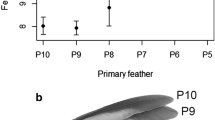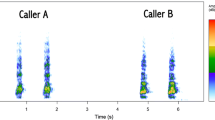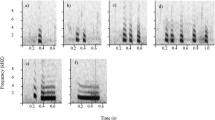Abstract
Male Orthoptera singing from exposed perches are at risk from acoustically- and visually-hunting predators. The defensive reactions of armored ground crickets (Acanthoplus speiseri) include falling silent, dropping from their perch, alarm stridulation and autohaemorrhaging. Male and female ground crickets show different reactivity (i.e. the number or intensity of defense tactics used) to predation, depending on level of exposure: calling males were more reactive when approached during daylight, compared with in the dark. During daylight, calling males were more reactive than silent, cryptic, males and females. The level of response presumably reflected the riskiness of the individual’s behavior and situation at that time. Plasticity of response to predation allows individuals to balance risky behavior (i.e. acoustic signaling from exposed perches) by being more reactive to potential threats.


Similar content being viewed by others
References
Bateman PW, Ferguson JWH (2004) Male mate choice and spermatophore size in the Botswana armoured ground cricket Acanthoplus discoidalis. Can, and how, do males judge female mating history? J Zool Lond 262:305–309
Bateman PW, Fleming PA (2006) Sex, intimidation and severed limbs: the effect of simulated predator attack and limb autotomy on calling behavior and level of caution in the field cricket Gryllus bimaculatus Behav. Ecol Sociobiol 59:674–681
Bateman PW, Fleming PA (2009) There will be blood: autohaemorrhage behaviour as part of the defence repertoire of an insect. J Zool Lond 278:342–348
Belwood JJ, Morris GK (1987) Bat predation and its influence on calling behavior in neotropical katydids. Science 238:64–67
Boevé J-L, Schaffner U (2003) Why does the larval integument of some sawfly species disrupt so easily? The harmful hemolymph hypothesis. Oecologia 134:104–111
Bothma JDP (1966) Notes on the stomach contents of certain Carnivora (Mammalia) from the Kalahari Gemsbok Park. Koedoe 9:37–39
Burk T (1982) Evolutionary significance of predation on sexually signalling males. Fla Entomol 65:90–104
Conti E, Viglianisi FM (2005) Ecology of the calling song of two Namibian armoured ground crickets, Acanthoplus longipes and Acanthoproctus diadematus (Orthoptera Tettigoniidae Hetrodinae). Ethol Ecol Evol 17:261–269
Glenn GS (1991) A systematic revision of Enyaliopsis Karsh 1887 (Orthoptera, Tettigoniidae, Hetrodinae). T Am Entomol Soc 117:67–102
Grzeschik K-H (1969) On the systematics, biology and ethology of Eugaster Serville (Orthoptera, Tettigoniidae). Form Funct 1:46–144
Gyssels FGM, Stoks R (2005) Threat-sensitive responses to predator attacks in a damselfly. Ethology 111:411–423
Hatle JD, Faragher SG (1998) Slow movement increases the survivorship of a chemically defended grasshopper in predatory encounters. Oecologia 115:260–267
Hedrick AV (2000) Crickets with extravagant mating songs compensate for predation risk with extra caution. Proc R Soc Lond Ser B-Biol Sci 267:671–675
Heller K-G (1996) Unusual abdomino-alary, defensive stridulatory mechanism in the bushcricket Pantecphylus cerambycinus (Orthoptera, Tettigonioidea, Pseudophyllidae). J Morphol 227:81–86
Irish J (1992) The Hetrodinae (Orthoptera: Ensifera: Bradypodidae) of southern Africa: systematics and phylogeny. Navorsinge van die Nasionale Museum, Bloemfontein 8:393–434
Kotiaho J et al (1998) Male mating success and risk of predation in a wolf spider: a balance between sexual and natural selection? J Anim Ecol 67:287–291
Kowalski K, Lakes-Harlan R (2011) Temporal patterns of intra- and interspecific acoustic signals differ in two closely related species of Acanthoplus (Orthoptera: Tettigoniidae: Hetrodinae). Zoology 114:29–35
Laurila A (2000) Behavioural responses to predator chemical cues and local variation in antipredator performance in Rana temporaria tadpoles. Oikos 88:159–168
Lea AJ, Blumstein DT (2011) Age and sex influence marmot antipredator behavior during periods of heightened risk. Behav Ecol Sociobiol 65:1525–1533
Lima SL (2009) Predators and the breeding bird: behavioral and reproductive flexibility under the risk of predation. Biol Rev 84:485–513
Lima SL, Bednekoff PA (1999) Temporal variation in danger drives antipredator behavior: the predation risk allocation hypothesis. Am Nat 153:649–659
Lima SL, Dill LM (1989) Behavioral decisions made under the risk of predation: a review and prospectus. Can J Zool 68:619–640
Loughry WJ, McDonough CM (1989) Calling and vigilance in California ground squirrels: age, sex, and seasonal differences in responses to calls. Am Midl Nat 121:312–321
Lymbery A, Bailey W (1980) Regurgitation as a possible antipredator defensive mechanism in the grasshopper Goniaea sp. (Acrididae, Orthoptera). J Aust Entomol Soc 19:129–130
Mbata KJ (1992a) The biology and host plant specificity of Acanthoplus speiseri Brancsik (Orthoptera: Tettigoniidae: Hetrodinae), a pest of grain crops. J Entomol Soc S Afr 55:99–106
Mbata KJ (1992b) Some observations on the reproductive behaviour of Acanthoplus speiseri Brancsik (Orthoptera: Tettigoniidae: Hetrodinae). Insect Sci Appl 13:19–26
Minja E et al (1999) Integrated Pest Management (IPM) components for control of armored bush cricket on pearl millet and sorghum in farmers’ fields in Namibia and Zambia. ISMN 40:47–50
Moore KA, Williams DD (1990) Novel Strategies in the complex defense repertoire of a stonefly (Pteronarcys dorsata) nymph. Oikos 57:49–56
Nicolson SW (1994) Water replenishment following reflex bleeding in the blister beetle Decapotoma lunata Pallas (Coleoptera: Meloidae). Afr Entomol 2:21–33
Robinson DJ, and Hall MJ (2002) Sound Signalling in Orthoptera. In: Evans P. (ed) Advances in Insect Physiology, vol 29. Elsevier Ltd, pp 151–278
Sih A (1986) Antipredator responses and the perception of danger by mosquito larvae. Ecology 67:434–441
Sih A (1992) Prey uncertainty and the balancing of antipredator and feeding needs. Am Nat 139:1052–1069
Simpson SJ et al (2006) Cannibal crickets on a forced march for protein and salt. Proc Nat Acad Sci USA 103:4152–4156
Smith ME, Belk MC (2001) Risk assessment in western mosquitofish (Gambusia affinis): do multiple cues have additive effects? Behav Ecol Sociobiol 51:101–107
StatSoft Inc. (2001) STATISTICA (data analysis software system). www.statsoft.com. In, version 6 edn
Sword GA (2001) Tasty on the outside, but toxic in the middle: grasshopper regurgitation and host plant-mediated toxicity to a vertebrate predator. Oecologia 128:416–421
Tikkanen P, Muotka T, Huhta A (1996) Fishless-stream mayflies express behavioural flexibility in response to predatory fish. Anim Behav 51:1391–1399
Visagie R, Anderson MD (2006) Lesser Kestrel (Falco naumanni) road mortalities in the eastern Karoo, South Africa. Gabar 17:1–9
Ydenberg RC, Dill LM (1986) The economics of fleeing from predators. Adv Study Behav 16:229–249
Zuk M, Kolluru GR (1998) Exploitation of sexual signals by predators and parasitoids. Q Rev Biol 73:415–443
Acknowledgments
We acknowledge funding from the University of Pretoria. Special thanks go to Romie Jackson for her considerable help and entertaining company during data collection. This paper is dedicated to Jamie T. – ‘the things I’ve done and the things I’ve seen’.
Author information
Authors and Affiliations
Corresponding author
Rights and permissions
About this article
Cite this article
Bateman, P.W., Fleming, P.A. Signaling or Not-Signaling: Variation in Vulnerability and Defense Tactics of Armored Ground Crickets (Acanthoplus Speiseri: Orthoptera, Tettigoniidae, Hetrodinae). J Insect Behav 26, 14–22 (2013). https://doi.org/10.1007/s10905-012-9329-5
Revised:
Accepted:
Published:
Issue Date:
DOI: https://doi.org/10.1007/s10905-012-9329-5




